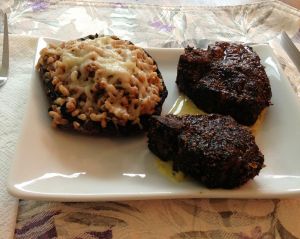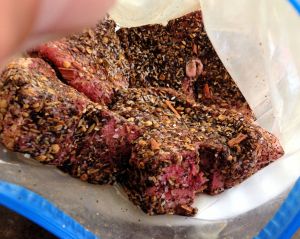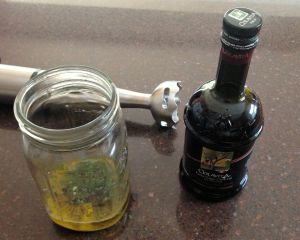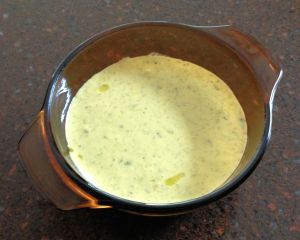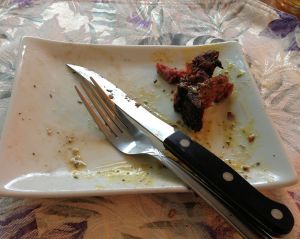Spice
Grilled Moroccan Lamb Chops with Mint Za’atar Aioli
OMG, every once and awhile you hit a homerun or a hole-in-one or so I have heard. It has never happened to me. From a recipe standpoint, this counts. If I were a professional chef, this would be my new signature dish. I seriously considered not sharing it, but I will be able to prove that I published it first. This is a new personal best.
I recently saw an episode of Guy’s Big Bite where Guy Fieri made Grilled Lamb Chops with Olive Tapenade. The lamb chops looked good, but I didn’t care for the direction of the Mediterranean theme. Grilled Moroccan Lamb Chops with Mint Za’atar Aioli was quickly conceived. Now I’ll admit the Espresso is not Moroccan or even a traditional meat spice, but it did give it a rich, earthy overtone and is a nice counterbalance to the sweetness of the lamb.
Toasting the coriander, cumin and cinnamon brings out the essential oils. I much prefer to toast and grind the spices than rely on pre-ground spices. Whether you consider this a dry rub, a dry brine or curing is up to you. The salt draws the moisture out of the lamb. The moisture mixes with the spices and is re-absorbed into the meat. This technique works great on your Thanksgiving Turkey and works just as well on the lamb chops.
Za’atar is a Mediterranean spice mix of dried herbs, sesame seeds and sumac (no, not the poison variety). You can make your own, pick some up at the international section of some supermarkets or buy it at a Mediterranean market or on the Internet. I can buy it at the local Wegman’s. The Mint Za’atar Aioli balances the richness of the lamb. You could do something similar with mint, za’atar and Greek yogurt. You could also omit the Za’atar if securing it proves too difficult. You will want to make the Aioli in advance to give the flavors a chance to meld.
The easy route is to use store bought ground spices and a spiced mayonnaise or Greek yogurt, but doing the prep is worth the effort.
I paired the lamb with Farro and Herb Stuffed Mushroom (that’s a recipe for another day) and a side salad straight from the garden for a tasty, healthy dinner.
Grilled Moroccan Lamb Chops
Ingredients:
4 Lamb Loin Chops (approx. 1 lb.)
1/2 Tbsp Whole Coriander Seeds
1/2 Tbsp Whole Cumin Seeds
1/2 Cinnamon Stick
1/2 Tbsp Ground Espresso Beans
1 1/2 tsp Kosher Salt
Directions:
1. Gently toast the Coriander Seeds, Cumin Seeds and Cinnamon stick in a hot, dry pan until fragrant. Grind the toasted spices in a spice mill or using a mortar and pestle. Thoroughly mix the spice mixture, ground Espresso Beans and Kosher Salt in a small bowl.
2. Place Lamb Loin Chops in a one Quart freezer storage bag. Generously coat Lamb Chops with the spice mixture. Seal the bag removing most of the air. Place into the refrigerator turning occasionally for 8 hours or overnight.
3. Remove the chops from the refrigerator one hour before grilling. Remove the chops from the bag. Brush off any excess spices, blot dry with paper towels and let air dry until ready to grill.
4. Set up your grill for both direct and indirect grilling. Over direct heat, quickly sear the Lamb Chops on both sides and then move them to indirect heat. Continue to grill until the internal temperature reaches 130 for medium-rare. Remove to a serving platter and let rest for 10 minutes before serving. The internal temperature should continue to rise to 135-140. Serve with Mint Za’atar Aioli (recipe below).
Mint Za’atar Aioli
Ingredients:
1 Egg Yolk
1 Tbsp Lime Juice
1/2 tsp Dijon Mustard
2 cloves Garlic, minced
1/3 cup Extra-Virgin Olive Oil
1/2 tsp Za’atar
1 tsp Fresh Mint, finely chopped
1/3 cup Extra-Virgin Olive Oil
Salt and Pepper, to taste
Directions:
1. Place all ingredients into a mason jar or similar vessel except for the oil, salt and pepper.
2. Insert an immersion blender into the bottom of the jar and blend for a minute to two.
3. Drizzle in the oil while contining to blend until thick and smooth. Salt and pepper to taste.
4. Refrigerate for several hours before serving to enhance the flavor.
5. Remove from refrigerator 1/2 before serving.
In the end, it’s just a couple of cleaned bones and a clean plate.
Thanksgiving 2011 — Semi-Mediterranean Theme
I decided to do something a little different this year and add some Mediterranean flare to Thanksgiving. For the traditionalist, I rounded it off with some traditional fare. The centerpiece of Thanksgiving is the bird so I went with a Mediterranean Turkey. There are no recipes that I could find for such a preparation (not many turkeys in that part of the world), so I went my own route.
THE MENU:
Turkey with Za’atar and Pomegranate Molasses – picked up both in the international section of Wegmans. The Pomegranate Molasses just happened to be on the shelf below the za’atar. I first brined the turkey in pomegranate cider with apples and oranges . . . and, of course, garlic. Before roasting, I generously coated the bird with a mixture of the za’atar and molasses inside and out.
Cornbread Stuffing with Merguez Sausage — This is a twist on my normal cornbread and sausage stuffing. Marguez is a Moroccan sausage typically made with lamb, beef or a combination of the two. I could not find Merguez so I made my own with a mixture of pork and lamb. The pork is not traditional (again they do not eat much pork in that part of the world), but goes better with turkey than beef would have.
Potato and Celery Root Gratin with Leeks — This recipe was from the November issue of Bon Appetit. Very good.
Roasted Squash and Yams — Cut up various squashes and a few yams, tossed them with EVOO and Za’atar and roasted them at 425 for 50 minutes.
Arugula and Mint Salad with Oil-Cured Black Olives, Oranges, and Ricotta Salata — Olive and mint continued the Mediterranean theme.
Cranberry, Fig, and Pinot Noir Chutney — Not your mother’s sweet/sour cranberry sauce. A rich, savory taste that perfectly complemented the meal. I doubled the recipe and still had little left. I made another double batch over the weekend.
Cranberry, Orange Relish — for the traditionalists in the crowd
Za’atar, Feta, Olives, and Green Onions Quick Bread — A savory bread for the Mediterranean theme.
Pumpkin Cranberry Bread — for those of us who do not care for feta and olives.
Great flavors and a step up from the normal Turkey-day fare. 17 people at the house, a 21 lb. bird and double recipes all the way around. We even had a few left-overs.
My First Time — Smoking Brisket that is: Saucing
To sauce or not to sauce; that is the question. The old-timer Texas brisket fans ate their brisket nekked. The dry rub and smoke gave the flavor. My ribs need no sauce, but I have to admit that I often slather on some Dinosaur sauce. The problem with sauce on brisket is that most of the commercial BBQ sauces are too sweet for brisket. For brisket, you need savory and to hold off on the excessive heat. The sauce should compliment the meat.
Sauces are one of those items on which BBQ enthusiasts enjoy disagreeing. I prefer traditional BBQ sauce for ribs and Eastern North Carolina BBQ sauce for pulled pork. Don’t confuse tomato based North Carolina BBQ sauce with real Eastern North Carolina BBQ sauce. True North Carolina BBQ sauce is simply vinegar infused with red pepper flakes. With pulled pork, add some collards, corn bread and hush puppies and you have heaven on earth. In Western NC, they add some ketchup to the sauce and you start the slippery slope toward traditional BBQ sauce.
One of the advantages of sauce is that it moistens tough and dry brisket and brisket is difficult to make tender and moist. To be on the safe side, I prepared some sauce. But what sauce to prepare?
I decided to try Texas BBQ Juice. This sauce is inspired by the sauce they make at Cooper’s Old Time Bar-B-Que in Llano, Texas. This sauce can be used as a mop while cooking and a BBQ sauce when eating. I’m not mopping, but I am eating.
This is not BBQ sauce as most people think of it. Most BBQ sauce has a heavy tomato sauce base with plenty of sugar and some spices. This is a brown sauce which Cooper’s actually refers to as a pepper sauce.
I halved the recipe and replaced the green bell pepper with a poblano for some additional spice and used maple sugar in place of the brown sugar. I also inadvertently did not half the beer, oh well. The first taste before it simmered was HOT. After simmering for 15 minutes, the flavors melded and smoothed out. It should be even better tomorrow after aging in the frig over night.
My First Time — Smoking Brisket that is: Preparation
I never smoked a beef brisket before. It takes quite a bit of time and that tends to be something of which I am short. I decided to tackle the task on Labor Day weekend.
Probably the only thing on which BBQ enthusiasts can agree is that BBQ enthusiasts can agree on nothing. When it comes to brisket, there are devotees on both side of every issue: whole packer, flat or point; trim the fat cap or leave it be; smoke fat up or fat down; dry rub or not; dry rub the day before or just before slapping the meat on the smoker; mop or don’t mop; use the Texas crutch or not; sauce or nekked; and the arguments go on. I guess the good thing is no matter what you do, someone will call it genius. It also leaves plenty of room for experimentation and that means many good and possibly some bad meals to come.
Whole packer, flat or point was decided for me by Wegmans. They only had flats in the case. I probably could have ordered a whole packer, but that would have taken planning ahead and inspiration hit too late. Trim or not: I like the argument that leaving the fat lets it melt and baste the brisket as it cooks. I cross hatched the fat layer down to the meat so that I could get some dry rub on that side, but left it intact this time. Once cooked, I will trim off the fat. My only fear is that some of that smoky goodness will disappear when I trim the fat.
I always dry rub my smoked meat. My ribs need no sauce because the rub adds so much flavor during the cooking. Pork and beef are different beasts so the rub should be distinct. In particular, a beef dry rub should have less sweetness. I lined up some popular brisket rub recipes and did some compare and contrast. There were ingredients on which all agreed. They went in. There were differences that I judged on personal preference and then I added some of my own.
My rub ended up as below:
- 2 tablespoons Kosher Salt
- 1 teaspoon Maple Sugar
- 1 teaspoon Ground cumin
- 3 tablespoon Black pepper
- 2 teaspoons Ancho chili powder
- 1 tablespoon Onion powder
- 2 teaspoons Garlic powder
- 1 teaspoon Chipotle chili powder
- 2 teaspoons Mustard Powder
I like my rub to have time to permeate the meat so I did it 36 hours in advance. I rubbed the brisket with some EVOO, rubbed in the dry rub, wrapped it tightly in plastic wrap and put it in the refrigerator. There it sits getting happy until I fire up the smoker tomorrow morning.
Experimenting with Za’atar
Za’atar is a Middle Eastern blend of herbs, sesame and salt. The blend varies from region to region, but is widely used. One of the main ingredients is Sumac. No, no, not the poison stuff we know in the NorthEastern US. Sumac spice is the dried, ground fruit of the Elm-Leaved Sumach or Tanner’s Sumach shrub.
I found a Chicken with Za’atar recipe in the July issue of Bon Appetit (http://tiny.cc/g0sg7) and made it a couple of weeks ago. Making the Za’atar proved to be a challenge because I cannot buy sumac spice locally. I was, however, able to purchase a package of pre-made za’atar. The recipe called for oregano and the pre-made was thyme based. The recipe called for cumin and the pre-made had none. Thyme goes well with chicken so not a problem. Adding cumin to the mix was easily done.
I substituted lime for the lemon since the better half is allergic.
Making the cumin aioli was very tedious, but well worth the effort. Whisking a drop or two of oil into the emulsion at a time is a slow process, but don’t take a short-cut and simply add cumin to mayo. Aiolis should always be made from scratch. Again, lime instead of lemon.
To accompany the dish, I made a Fattoush salad (http://tiny.cc/x7y4u). Fattoush is seasoned with za’atar so the theme continued. Since fattoush is made from local, fresh vegetables, I added some grilled corn to the recipe to give it a more local feel.
I added some grilled flat bread sprinkled with, you guessed it, za’atar. I basted the bread with EVOO, sprinkled with za’atar and threw it on the grill for a couple of minutes per side.
Great meal! Flavorful chicken, a bright, fresh salad and tasty bread. I am now going to order some sumac spice and experiment with regional variations. Should be fun and tasty.
